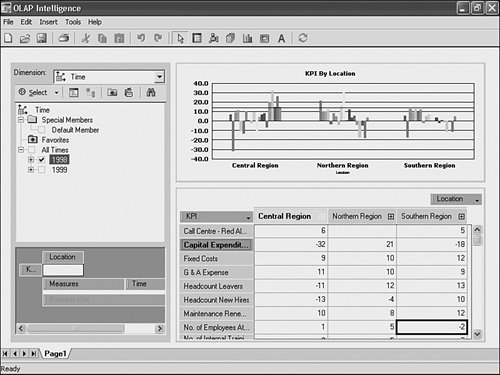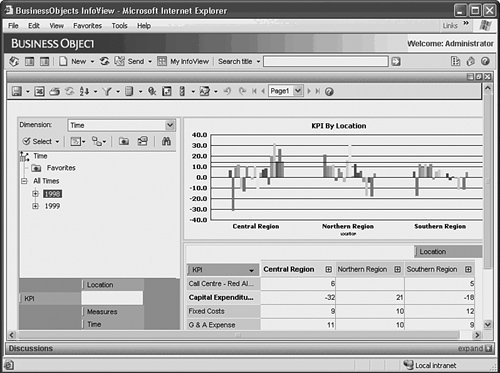Introducing OLAP Intelligence
| OLAP Intelligence is another type of reporting tool provided by Business Objects that enables organizations to deliver action-based analysis to end users. More than the flattened views of OLAP and multidimensional data sources that Crystal Reports provides, it offers a rich, interactive interface that facilitates the discovery of business insights and helps decision-makers affect business performance at the speed of thought. The two primary groups of end users for such reports would be Power Users and General Information Consumers. Power Users can create analytic reports (historically sometimes called applications) based on OLAP data, using the powerful thick-client designer OLAP Intelligence. These reports or applications (which will be called reports from here on) can contain many pages, each representative of a different predefined view of the underlying data source. Data can be presented in tables or through a wide range of charts, as shown in Figure 19.1. Figure 19.1. Design an analytic report with OLAP Intelligence. General Information Consumers can also leverage the powerful multidimensional functionality of OLAP Intelligence by taking advantage of the guided analytics provided in the product. These single-click analytic buttons used in combination with the other compelling presentation features (such as exception highlighting, sorting and filtering, and drop-down boxes) enable you to provide multidimensional analysis to less sophisticated users. Business managers can use the resulting analytic reports to inform the daily decisions they need to make with less technical skill required. Analytic reports can be delivered to users in two ways: either through distribution of the OLAP Intelligence file (.car extension) to users with the thick-client application installed, or, more popularly, through a Web browser by using BusinessObjects Enterprise. The reports in BusinessObjects Enterprise can be viewed using either Dynamic HTML (DHTML) (see Figure 19.2) or ActiveX. Both viewers are fully functional and provide all the analytic capabilities of the desktop tool in a Web browser. Figure 19.2. An analytic report viewed using the DHTML Viewer of BusinessObjects Enterprise. OLAP Intelligence is suitable for a wide range of analytic business requirements, including sales and marketing analysis, financial reporting and analysis, key performance indicator reporting, supplier performance and billing analysis, click-stream analysis, and HR analysis. When combined with BusinessObjects Enterprise in providing web analytic solutions, OLAP Intelligence is also suitable for delivering analytic reports to both employees inside an organization and to those outsidecustomers, suppliers, and business partners. Note Before using OLAP Intelligence it is necessary to have OLAP cubes created. The OLAP cubes supported include
The most recently supported OLAP servers can be accessed from the platform.txt file that come with your Business Objects software. |
EAN: 2147483647
Pages: 365